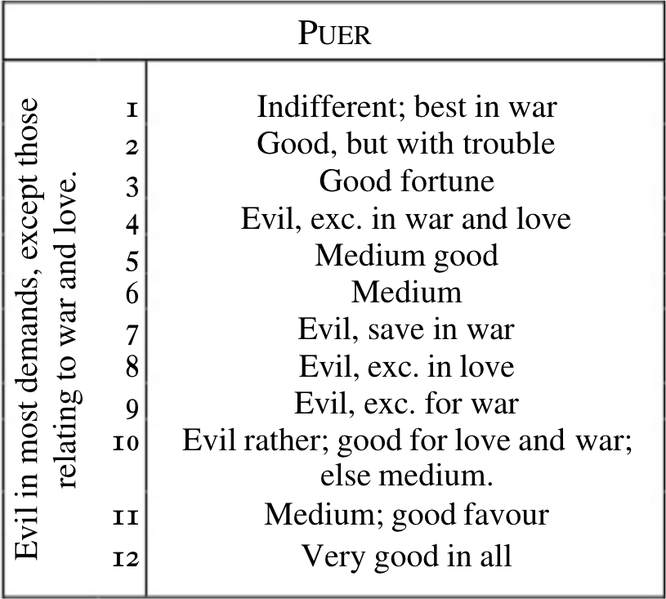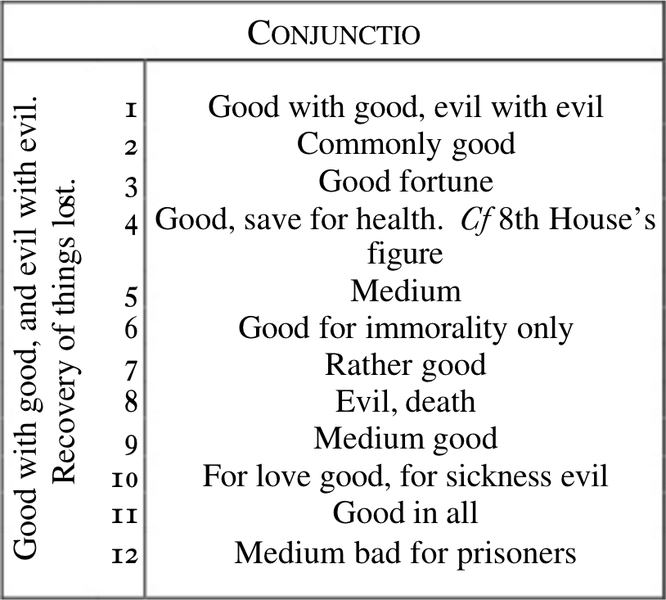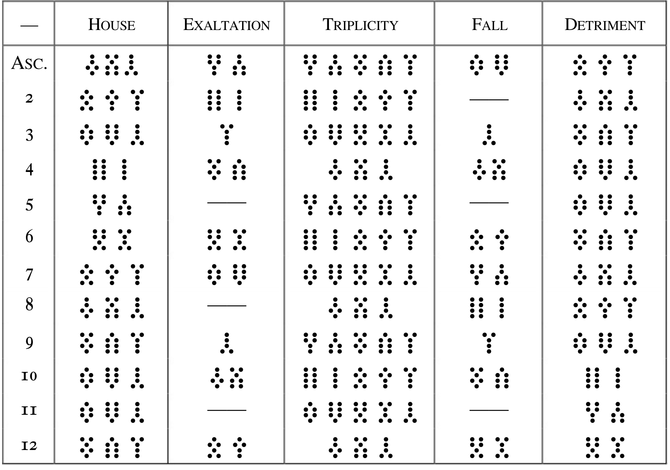|
|
 |
|
EXAMPLE
|
| Acqusitio: | Fortuna Minor: |
 |
 |
| Amissio: | Laetitia: |
 |
 |
| Fortuna Major: | Tristitia: |
 |
 |
| Puella: | Albus: |
 |
 |
| Puer: | Conjuctio: |
 |
 |
| Rubeus: | Carcer: |
 |
 |
| Caput Draconis: | Via: |
 |
 |
| Cauda Draconis: | Populus: |
 |
 |
BY Essential Dignity is meant the strength of a figure when found in a particular House. A figure is therefore strongest in what is called its House; very strong in its Exaltation; strong in its Triplicity; very weak in its Fall; weakest of all in its Detriment. A figure is in its Fall when in a House opposite to that of its Exaltation; in its Detriment when opposite to its own House.
The following list shows the Essential Dignities; that is to say, they follow the Dignities of their Ruling Planets, considering the twelve Houses of the scheme as answering to the twelve signs, thus: ASC. to ♈ (Aries), 2 to ♉ (Taurus), 3 to ♊ (Gemini), &c., … 12 to ♓ (Pisces). Therefore Mars figures will be strong in ASC. and weak in 7th and so on. See chapter i. for attribution of figures to planets.
![]() (Caput Draconis) is strong in Dignities of ♃ (Jupiter) and ♀(Venus)
(Caput Draconis) is strong in Dignities of ♃ (Jupiter) and ♀(Venus)
![]() (Cauda Draconis) is strong in Dignities of ♄ (Saturn) and ♂ (Mars)
(Cauda Draconis) is strong in Dignities of ♄ (Saturn) and ♂ (Mars)

The ASC. is aspected by 11, 10, 9 (as ⚹ (Sextile) □ (Quartile) and 🜂 (Trine)) Dexter and by 3, 4, 5 … Sinister, and has 7 in opposition.
The Dexter aspect is that which is contrary to the natural order of the Houses; it is stronger than the Sinister. So for other Houses.
Figures have Friends and Enemies:
— ♄ (Saturn) = Friends: ♃ (Jupiter) ☉ (Sun) ☿ (Mercury) ☾ (Moon); and Enemies: ♂ (Mars) ♀ (Venus).
— ♃ (Jupiter) = Friends: ♄ (Saturn) ☉ (Sun) Venus ☿ (Mercury) ☾ (Moon); and Enemies: ♂ (Mars).
— ♂ (Mars) = Friends: ♀ (Venus); and Enemies: ☾ (Moon) ♄ (Saturn) ☉ (Sun) ☿ (Mercury).
— ☉ (Sun) = Friends: ♃ (Jupiter) ☉ (Sun) ♀ (Venus) ☿ (Mercury) ☾ (Moon); and Enemies: ♄ (Saturn).
— ♀ (Venus) = Friends: ♃ (Jupiter) ☉ (Sun) ♂ (Mars) ☿ (Mercury) ☾ (Moon); and Enemies: ♄ (Saturn).
— ☿ (Mercury) = Friends: ♄ (Saturn) ♃ (Jupiter) ☉ (Sun) ♀ (Venus) ☾ (Moon); and Enemies: ♂ (Mars).
— ☾ (Moon) = Friends: ♃ (Jupiter) ☉ (Sun) ♀ (Venus) ☿ (Mercury); and Enemies: ♄ (Saturn) ♂ (Mars).
Also figures of 🜂 {Fire} are sympathetic with those of 🜂 {Fire}, friendly with 🜁 {Air} and Earth; hostile to 🜄 {Water}.
So 🜄 {Water} is sympathetic with 🜄 {Water}, friendly 🜁 {Air} and 🜃 {Earth}, and hostile to 🜂 {Fire}
🜁 {Air} is sympathetic with 🜁 {Air}, friendly 🜂 {Fire} and 🜄 {Water} , and hostile to 🜃 {Earth}.
🜃 {Earth} is sympathetic with. 🜃 {Earth}, friendly 🜄 {Water} and 🜂 {Fire}, and hostile to 🜁 {Air}.
Again, sign figures are friends to those ⚹ (Sextile) or 🜂 (Trine), and hostile to those □ (Quartile) or in ☍ (Opposition).
REMEMBER always that if ![]() (Rubeus) or
(Rubeus) or ![]() (Caput Draconis) fall in the Ascendant, the figure is not fit for judgment. Destroy it instantly, and erect a new figure not less than two hours afterwards.
(Caput Draconis) fall in the Ascendant, the figure is not fit for judgment. Destroy it instantly, and erect a new figure not less than two hours afterwards.
Your figure being thoroughly arranged as in Chapter III., note first to what House the demand belongs. Then look for Witnesses and Judge in their special table, and see what is said under the head of the demand. Put this down. Note next what figure falls in the House required (if it spring into other Houses, these too should be considered); “e.g.”, in a question of money stolen, if the figure in 2nd be also in 6th it might show the thief to be a servant in the house. Look next in the Table of Figures in the Houses, and see what the figure signifies in the especial House under consideration. Put this down also. Then by the Table of Aspects (Chapter VI.) note down the figures ⚹ (Sextile) □ (Quartile) 🜂 (Trine) and ☍ (Opposition), putting good on one side, evil on the other; noting also the strength or weakness, friendliness or hostility to the figure in the House required, of these figures. Then add the meaning of the figure in the 4th, to signify the end of the matter. It may also assist you to form a Reconciler from the figure in the House required and the Judge, noting what figure results and whether it harmonises with one or both by nature (Chapter VI). Now consider all you have written, and according to the balance of Good and Evil, form your final judgment. Consider also always in money questions where the part of Fortune falls.
Take, “e.g.”, the figure in Chapter III., and form a judgment for loss of money in business therefrom.
Tables of Witnesses and Judge say: Moderate.
In 2nd is ![]() (Carcer). Evil, showing obstacle, delay.
(Carcer). Evil, showing obstacle, delay.
Part of Fortune ⊕ (Earth) is in ASC. with ![]() (Amissio), showing loss through Querent's own blunders.
(Amissio), showing loss through Querent's own blunders.
![]() (Carcer) springs into no other House; ∴ this does not affect the question.
(Carcer) springs into no other House; ∴ this does not affect the question.
The figures ⚹ (Sextile) and 🜂 (Trine) of 2nd are ![]() (Conjunctio),
(Conjunctio), ![]() (Fortuna Minor),
(Fortuna Minor), ![]() (Fortuna Major), and
(Fortuna Major), and ![]() (Acquisitio), all good figures and friendly in nature = Well-intentioned help of friends.
(Acquisitio), all good figures and friendly in nature = Well-intentioned help of friends.
The figures □ (Quartile) and r in ☍ (Opposition) are ![]() (Fortuna Minor),
(Fortuna Minor), ![]() (Conjunctio),
(Conjunctio), ![]() (Albus), which are not hostile to
(Albus), which are not hostile to ![]() (Carcer); therefore shows opposition not great.
(Carcer); therefore shows opposition not great.
The figure in the 4th is ![]() (Fortuna Major), which shows a good end, but with anxiety.
(Fortuna Major), which shows a good end, but with anxiety.
Forming a Reconciler, we get ![]() (Fortuna Minor) again, a sympathetic figure, but denoting delay = Delay, but helping Querent's wishes.
(Fortuna Minor) again, a sympathetic figure, but denoting delay = Delay, but helping Querent's wishes.
Adding all together —
1. Medium;
2. Evil and obstacles, delay;
3. Loss through Querent's self;
4. Strength for evil, medium only;
5. Well-intentioned aid of friends;
6. Not much opposition from enemies;
7. Ending good, but with anxiety;
8. Delay, but helping Querent's wishes — we formulate this judgment:
That the Querent's loss in business has been principally owing to his own mismanagement; that he will have a long and hard struggle, but will meet with help from friends; that his obstacles will gradually give way; and that after much anxiety he will eventually recoup himself for his previous losses.

This is another illustration by Austin Osman Spare,
formed this time in an abstract of female primary and secondary sexual attributes in contrast to the male elements in the first.
There is a large face suggested in the drawing, to the right and center.
Transcriber’s notes. This text was first published in Equinox I (2) in 1909. That publication was prefixed by a note reading:
This work derives in the first instance from a lecture on Geomancy which circulated in the Golden Dawn. Another version was published by F.I. Regardie in the two versions of the G.D. papers he edited; both of these however omitted the tables of Witnesses and Judge, though they included material omitted by Crowley. The method is in most respects similar to that taught in the Geomantica disciplina lectura by Heinrich Cornelius Agrippa which appeared in vol. I of the Lyon edition of Agrippa’s Opera and was one of the six texts on magic and divination from that volume translated into English by Robert Turner (Henry Cornelius Agrippa’s Fourth Book of Occult Philosophy and of Geomancy &c. &c. &c., London, 1655) although elements appear to have been drawn from other late-mediæval and Renaissance works on the subject (the sigils of the planetary spirits and the tables of witness and judge, for instance, are not in Agrippa or the other short work on Geomancy, attributed to Gerald of Cremona, which was bound up in Agrippa’s Opera; the attributions of the figures to the signs of the Zodiac differ in a couple of cases). Geomantic divination is possibly of African or Middle Eastern origin: systems of divination employing the same set of figures have been recorded in West Africa and Malagasy, though these lack the elaboration of Agrippa’s method. Traditionally the figures would be obtained by making the marks in sand or dry earth with a stick rather than on paper. The quotation at the beginning attributed to “Zoroaster” is from the Chaldæan Oracles and forms fragment 144 in the Westcott edition (fragment 64 in the Kroll collection); it was quoted in the works of Michael Psellos, the Byzantine Platonist. The MACANEH square is from The Book of the Sacred Magic of Abramelin the Mage, Book III, cap. X, its is said to “hinder Sorcerers from operating.” The drawings which appear at the start and end are by Austin Spare, who at the time was a probationer of A∴A∴ (Spare contributed two other illustrations to that issue of the Equinox, namely renditions of the Golden Dawn Eden diagrams). The sigils of the planetary spirits as used in Geomancy differ from the forms obtained by plotting their names on the planetary “magic squares,” and were deliberately omitted by Crowley when editing the lecture. Regardie gives them as follows (I have not so far managed to find an earlier source):
The “appropriate Pentagram” (Chapter II.) is an invoking Earth pentagram, traced with the first stroke from top to bottom left. To clarify the rules for obtaining the remaining figures from the three Mothers (Chapter II.): the first Daughter is composed of the first row of each of the four Mothers in turn, the second from the second row of each, etc. (that is: row x of Daughter y is taken from row y of Mother x). Then figures are combined in pairs as stated by modulo 2 addition: i.e. take each row in turn: if the total number of dots in that row in the two figures is odd, one dot is marked in the corresponding row of the new figure. If the total number is even, mark two dots in the new figure. Note that owing to the method used to generate it, the Judge will always have an even number of points; if the total number of marks made when generating the original four figures was even, both Witnesses will have an even number of points, otherwise they will both have an odd number of points. In the table of Essential Dignities (Chapter VI.), the geomantic figures were originally represented by binary numbers (1111 for Via, 1112 for Cauda Draconis, etc.). To explain the how this table was constructed: for each house take the Zodiac sign corresponding (Aries for the ascendant, Taurus for the second house, etc.). In the column “House” place those figures that fall under the planet ruling the sign in question. Caput Draconis is placed with signs ruled by either Venus or Jupiter; Cauda Draconis with signs ruled by either Mars or Saturn. In the column “Exaltation” place the figures corresponding to the planet exalted in the sign in question; since the nodes of the moon are included in the scheme of exaltations, they are placed there and not with Saturn, Jupiter, Mars or Venus. In “Triplicity”, rather than following the Elements in the first table, place figures under Sol and Jupiter (including Caput Draconis) with Fire signs, figures under Luna and Venus (including Caput Draconis) with Water signs, figures under Saturn and Mercury (including Cauda Draconis) with Air signs, and figures under Mars (including Cauda Draconis) with Water signs. The remaining two columns are straightforward if one bears in mind that a planet is in its fall in a sign opposite one where it is exalted, and in its detriment in a sign opposite one it rules. The system taught in Gerald of Cremona’s Astronomical Geomancy differs radically from the Agrippa / G.D. approach. In this, a single Geomancy figure is obtained in the usual way, and the Zodiac sign corresponding placed in the Ascendent: the remaining 11 signs are then placed around the figure in their usual order (Gerard has a somewhat different set of Zodiacal attributions to Agrippa; but in any case the fact that there are 16 figures and 12 Signs mean some signs are more likely to occur than others); then for each of the Planets (in order ! ☉ , ☽︎ , ♀ , ☿ , ♄ , ♃ , ♂), and Caput Draconis, make four rows of points but instead of using these to obtain another figure, count up the total number of points and divide by twelve; take the remainder (or 12, if the number is exactly divisible by 12) and place that planet in the house corresponding. Cauda Draconis, obviously, is placed opposite Caput Draconis. This gives you an artificial astrological figure which can then be judged according to the rules for aspects, planets in signs and houses, etc. The Latin title and number (96 being the total number of points in the 16 figures of Geomancy) are as given in the Syllabus of the Official Instructions of A∴A∴ in Equinox I (10). - T.S. |
Proof read and edited by Frater D.M.T.
Contributed to Bahlasti Ompehda O.T.O. (Hungary, Anno iX)

2014-2019 © O.T.O. Hungary